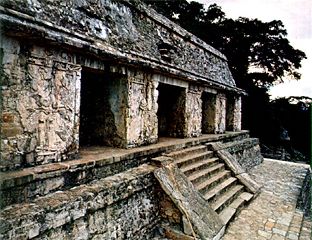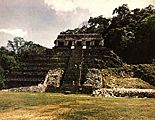
Sculptured stucco piers on the facade of the Temple of the Inscriptions. (Photo: Merle Greene Robertson.)
That the Maya artists of Palenque were quite aware of the implications of the viewpoint of the beholder can be clearly seen from the way in which they positioned their stucco sculptured piers on the Temple of the Inscriptions, both with respect to their location on the building itself and with respect to the distance and angle from which they would be seen.
For example, the piers of the Temple of the Inscriptions, sculptured with single frontal figures, painted in brilliant red, blue and yellow, appear from the distance as guardian sentinals standing erect and majestic at their stations at the entrance to this funerary temple. "The distance necessary for the visual projection," Hildebrand says, "has no direct relation to the precision or vagueness of the picture," nor is the scle of the representation dependent upon the question of distance.
Now, the pyramid substructure leading up to the base of the temple and also to the base of the piers, is approximately forty meters high, ascending at an angle of approximately 42 degrees.

 zoom
zoom